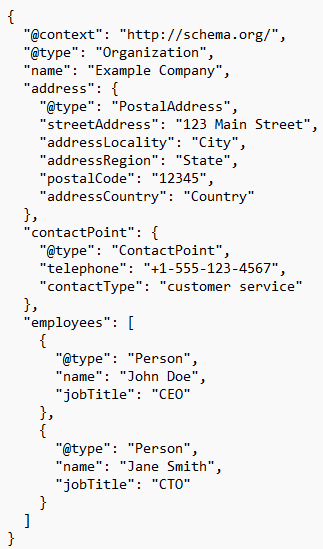Targeting content for keywords will result in a certain level of success, but when dealing with enterprise websites in particular it’s important to ensure that they are optimised for entities if you really want to elevate your ROI.
Not only does entity building result in enhanced search visibility and an improved user experience, adopting an entity-first approach can give SEOs a competitive advantage over sites which are still using traditional SEO practices.
That’s because turning enterprise content into structured data with a focus on entity optimisation will result in benefits such as improved search relevance, enhanced visibility in rich snippets and a rise in voice search discoverability.
Creating a robust entity building strategy is therefore an important step every SEO should take when performing content audits, content gap analyses and keyword research.
By incorporating an entity-first approach, large volumes of content will be classified and structured in the best way for both users and search engines to parse their relevance.
These are our top 6 steps towards creating a robust entity building strategy.
1. Conduct an entities gap analysis
By understanding where the entities gaps exist in your content, you will be able to build out comprehensive and relevant information across your site which will help content to be indexed more efficiently and rank more visibly.
To perform an entities gap analysis, the first step is to identify your target entities. You want to figure out which entities are most relevant to your website or industry. This is done by going beyond your website’s main theme or focus and understanding your target audience.
Identifying the entities relevant to their interests, needs and queries is key so that content can be mapped out in anticipation of their search queries. This can be done by performing keyword research, analysing competitor websites, conducting market research and more.
After that, conduct a content inventory. Take note of the content which exists across the site and make a list of the entities present within each piece of content. You can do this manually or automate the process.
Here’s a sample piece of text with the entities extracted and classified:
The fox climbed over the log to get to the frog. The frog was frightened and asked the fox to spare him. The fox was feeling generous and showed mercy. The frog hopped away across the river and the fox returned to the woods.
Entity: fox
Type: animal
Entity: log
Type: object
Entity: frog
Type: animal
Entity: river
Type: place
Entity: woods
Type: place
However, with large datasets or substantial quantities of unstructured text data, using Named Entity Recognition (NER) tools designed for content classification-focused entity recognition can speed up the process. A Google search will yield many options to choose from.
Next, compare your entities with the target entities identified and figure out where the gaps reside. Again, there are many tools out there to assist with knowledge graph management, semantic data catalogues and more – we list some of our favourites here.
Keyword research comes next, where you will be able to identify the keywords and search terms which are related to your target entities. By gathering this data, you will be able to understand the language and terminology users are implementing in their search queries.
New content can be created – or existing content updated – to address the entity gaps. Don’t forget to optimise the on-page elements for relevant keywords and entity mentions, and be sure to regularly monitor the performance of this optimised content over time.
2. Go deeper with entity mapping
In some situations, entity gap analysis may be enough to give your semantic SEO a boost. However, entity mapping can provide users and search engines with further relational context between entities and their attributes.
To get started, perform the steps in the entities gap analysis until you have extracted and classified the entities present across your site. You now have the resources to begin entity mapping.
In essence, this process involves establishing connections or relationships between different entities on a site. The entities are mapped based on attributes, relationships and semantic connections. Once complete, you are left with a structured representation of the entities and their relational connections.
This can be done manually by analysing the context in which the entities are mentioned to infer relationships. You want to seek co-occurrence patterns or semantic clues such as frequency or specific patterns to indicate relationships.
However, there are tools which can expedite this process for enterprise datasets. For example, knowledge graphs like Neo4j, NLP libraries like SpaCy and machine learning frameworks such as TensorFlow can also be used for automated relationship extraction and querying tasks.
Once you have mapped your entities, you will want to design the schema representation using data modelling languages such as JSON-LD, RDF or XML. Here is an example schema representation using JSON-LD for capturing entity relationships:

Here, the “Organisation” entity has been defined using attributes such as “name” and “address”, while the ‘contactPoint” attribute symbolises the relationship between the organisation and a contact point. It then specifies details about the customer service available.
The “employees” attribute indicates the relationship between the organisation and several “Person” entities. The attributes “name” and “jobTitle” define each person’s relationship with the organisation.
3. Conduct a schema markup audit
So you’ve built out your schema representation and inserted it into the HTML source code (or used one of the many CMS plugins to automate the schema markup code generation). Now is a good time to stop and evaluate your existing schema markup, especially if you’re in the process of a website redesign or migration.
You want to ensure all of your URLs have appropriate schema markup applied after you have completed your entities gap analysis and made the necessary content upgrades. After all, your hard work building out entities and mapping their relationships needs to be properly understood by search engines.
We recommend using a paid tool such as Screaming Frog for your audit, as the software has a comprehensive schema audit available which will identify issues such as missing structured data, validation errors and validation warnings.
You can then either implement the markup error fixes with CMS plugins or write scripts manually to implement via HTML. Just be sure to check the markup was found and processed within GSC and monitor results with a tool such as SEMRush.
4. Tackle intent disambiguation
Depending on your niche, intent disambiguation may be a necessary part of the entity building process. In essence, intent disambiguation involves determining the intended meaning or purpose behind a user’s query or search intent when ambiguity or multiple possible interpretations exist. A basic example is the query “apple”, which could refer to the fruit or the technology company.
To perform intent disambiguation, the following steps are required:
Analyse user queries. Seek patterns, common themes and potential ambiguities in the queries. You want to look at the user profile and multiple contexts including the session, device, location and time. The referring source, previous interactions with the site and external factors such as current events can also assist with disambiguation.
Identify ambiguous queries. Criteria can include:
- Word variations e.g. ‘watch’ could refer to a timepiece or the verb indicating observation
- Polysemous terms e.g. ‘bank’ could be a financial institution or the side of a river
- Lack of context e.g. the query ‘Apple Store’ could relate to a technology store or a shop selling the fruit
- Ambiguous modifiers e.g. words like ‘best’, ‘top’ or ‘cheap’ could introduce ambiguity; e.g. ‘best food’ could mean ‘healthiest’ for some and ‘tastiest’ for others
Perform keyword analysis. Look into the keywords and phrases in the query with an aim to find specific terms which assist with disambiguating the intent and associating it with a particular entity. For example, words like “buy”, “reviews” or “location” can help to clarify the user’s intent.
Map the entities. Next, match the user query to the relevant entities. Your existing entity mapping work will ensure you have a data resource to expedite this process.
Optimise your content. Ensure your content is optimised to address the specific intent associated with the mapped entities.
Monitor its performance. Track user behaviour to evaluate the effectiveness of your intent disambiguation process. Metrics to analyse include CTR, dwell time, bounce rates and conversions.
5. Consider semantic distance
If you want to apply an advanced entity building technique to your site, consider measuring the semantic distance of your entities.
Semantic distance is a quantifiable measure of the similarity or relatedness between two entities based on their meaning or semantic content.
There are a number of approaches you can take to measure semantic distances within a large corpus of text.
You can utilise semantic models such as word embeddings or topic modelling techniques to capture the semantic relationships between entities and the associated attributes.
The models generate vector representations which allow for the calculation of semantic distance. Well-known topic modelling algorithms include Latent Dirichlet Allocation (LDA) or Non-Negative Matrix Factorisation (NMF).
From there, similarity metrics such as cosine similarity, Jaccard similarity or Euclidean distance can be used to analyse the vector representation and quantify the resulting similarity.
Once semantic relationships have been identified, data visualisation techniques such as word clouds, network graphs or heat maps can be used to represent the semantic space around your website entities.
At this point, you will be able to review and interpret your findings. You can identify important concepts, keywords or relationships to inform your content strategy efforts. This resource can easily be applied to your entity gap analysis at the content creation stage.
6. Calculate your entity salience scores
Another advanced technique you can choose to dig into is calculating your entity salience scores.
Entity salience refers to the importance or prominence of an entity within a given piece of content. It will indicate the level of significance an entity holds in relation to other entities discussed within the same context.
When calculating an entity salience score, contributing factors include the frequency of entity mentions, its position within the text, contextual relevance and the role it plays in the narrative or discourse.
SEOs can optimise for entity salience to enhance the visibility and relevance of important entities within their content.
Benefits of performing this process include demonstrating a deeper understanding of the semantic relationships and context within your content, showcasing your expertise and authority on the topic and subsequently satisfying E-E-A-T criteria.
Plus, optimising for entity salience improves the chances of your content being selected for featured snippets or rich results.
Once you have performed your entity gap analysis and identified the key entities relevant to your content, you can begin calculating the salience of your entities.
The metrics for calculating a salience score depends on the text being analysed. In the world of natural language processing, the score is essentially a prediction of what users would classify as the most important entities.
That being said, Google’s Natural Language AI considers factors such as the entity’s position in the text, clarity, grammatical role and reference counts.
To dig deeper, you may consider entities which are mentioned more frequently to be more salient. You may assign a higher salience score to entities mentioned in headings, subheadings or prominent sections.
Those entities with significant contextual relevance to the main topic or theme of the content could be ranked more highly. Semantic similarity and user engagement can also be viable metrics for salience score calculations.
Once you have your most salient entities, you can incorporate them into your optimised content by placing them strategically throughout the copy. This will help search engines and readers to quickly identify the core entities in the content.
It will also be beneficial to provide relevant context and information about the salient entities by describing their attributes, functions or significance in relation to the topic.
If you are conducting a schema markup audit, you may take this opportunity to explicitly define and highlight salient entities to help search engines understand the relative prominence of entities as well as their relational distance to others within the text. This will increase your chances of appearing in rich snippets in the SERPs.
Need help with your entity building strategy?
If you’re struggling with creating your entity building strategy, our Free Acquisitions Workshop is here to help.
Our experienced marketing experts will address any concerns you may have during a free 30-minute discussion, followed by a tailored action plan and free further resources to help all aspects of your SEO strategy. Don’t miss out and book your slot today.












